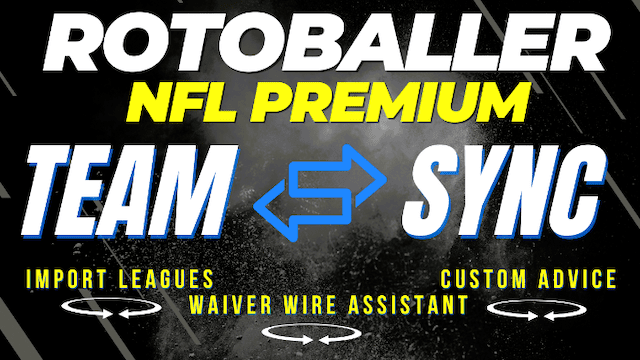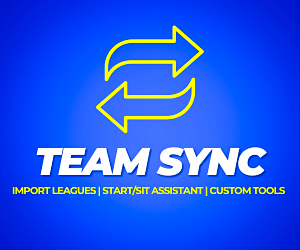Ryan's fantasy football Guillotine League strategy including how to win your Guillotine League, how to play, roster strategy, FAAB bidding, draft targets and more.
The most recent data that's available tells us more than 30 million people play fantasy football on an annual basis. Most of them play on popular fantasy platforms like ESPN, Yahoo, CBS, or Sleeper. But with that many people playing and so much time and energy invested in the hobby, there are bound to be innovations and evolution of fantasy football. Guillotine Leagues are the next step in that evolution.
The original premise is codified on the website of the original Guillotine Leagues. But recently, other fantasy platforms such as Yahoo and Sleeper have begun to adopt the new format, sensing its growing popularity among fantasy enthusiasts. As a result, analysts and fantasy football websites (like this one!) are beginning to provide more and more content around the strategy and fundamentals of Guillotine Leagues.
This piece will provide a high-level overview of Guillotine Leagues, looking at the rules, scoring, roster strategy, and in-season management. The innovative nature of the format allows for a number of distinct changes from traditional fantasy leagues, and anyone looking for a change of pace in their fantasy football diet should give them a try.
Be sure to check all of our fantasy football rankings for 2025:- 2025 fantasy football rankings
- Running back (RB) fantasy football rankings
- Wide receiver (WR) fantasy football rankings
- Tight end (TE) fantasy football rankings
- Quarterback (QB) fantasy football rankings
- FLEX fantasy football rankings
- Defense (D/ST) fantasy football rankings
- Kicker (K) fantasy football rankings
- Dynasty fantasy football rankings
What is a Fantasy Football Guillotine League?
Guillotine Leagues are leagues where one team from every league is chopped (or eliminated) every week of the season. In these leagues, there is no weekly, head-to-head matchup, but rather your team's overall score competes with every other team in the league to stay out of the bottom. The lowest score in the league every week means elimination, with no hope of returning to that league.
When a team is chopped on any given week in the fantasy football season, an interesting thing happens. The entire roster enters the waiver wire. Over the course of 18 weeks of the NFL season, one team per week will go under the guillotine until there is just one team left standing when Week 18 comes to an end. That last team will be declared the winner of that specific Guillotine League.
The wait is over — Guillotine Leagues paid contests are now LIVE!
Survive the chop. 🪓
Enter if you dare: https://t.co/lxxekE2TLo pic.twitter.com/XnEiQTSyDE
— Guillotine Leagues (@GLchop) July 31, 2025
The original Guillotine League’s official website offers free, public leagues in addition to paid public leagues. They also provide the opportunity to create custom, private leagues with prizes ranging from zero to anything the league desires. These private leagues are fully customizable for scoring, rosters, time, etc. There are fast and slow draft options available, and there are even partial-season leagues for a smaller number of teams.
Guillotine League Roster and Positions
The standard Guillotine League consists of 18 teams and lasts the entire NFL regular season. The reason for so many teams is that one team is eliminated each week of the regular season, thus requiring 18 teams to exist. However, there are shortened options available as well. If you set up a custom league that only runs the first 12 weeks of the season, that league would have 12 teams.
In a standard Guillotine League, rosters consist of 14 players (8 starters and 6 reserves). Starting lineups must have the following:
Quarterback: 1
Running Back: 2
Wide Receiver: 2
Tight End: 1
FLEX (RB/WR/TE): 2
Bench: 6
In standard leagues, there are no Superflex or 2 QB options. Users can create leagues with no bench, and the entire eight-person team would be their starting lineup. As with any fantasy league, once players' games have started, they can not be removed from the starting lineup. They can, however, be shifted between running back, wide receiver, and FLEX, depending on their eligibility.
Guillotine League Scoring
While there are some differences between the rosters in Guillotine Leagues and more standard redraft leagues, the default scoring system will be something familiar to many fantasy football players. In terms of scoring and the weekly competition, however, you will not be matched up against another team.
All teams are competing to stay out of the bottom spot every week. As long as your team does not finish there, it doesn't matter where you end up. With that known, let's look at how these leagues are scored for each of the fantasy categories.
Passing
Guillotine Leagues deploy a standard four-point per touchdown setting for quarterbacks. Passing stats for any player are as follows:
Passing Yards: .04 for each (1 for every 25 yards)
Passing Touchdowns: 4 for each
Passing 2-Point Conversions: 2 for each
Receiving
Guillotine Leagues are defaulted to a point-per-reception format, and then use standard receiving fantasy points.
Receptions: 1 for each
Receiving Yards: .1 for each (1 for every 10 yards)
Receiving Touchdowns: 6 for each
Receiving 2-Point Conversions: 2 for each
Kickoff or Punt Return Touchdowns: 6 for each
Rushing
Rushing points (for running backs, quarterbacks, and wide receivers) are set at the industry standard for Guillotine Leagues.
Rushing Yards: .1 for each (1 for every 10 yards)
Rushing Touchdowns: 6 for each
Rushing 2-Point Conversions: 2 for each
Kickers and Defense
With no kickers or defense drafted in these default leagues, no points accrue for anything related to defense or the kicking game. This also brings into play the Travis Hunter rule. Guillotine Leagues have accommodated his circumstances, and he will be awarded six points for an interception touchdown or a fumble recovery touchdown this year. However, he will also be docked two points if he fumbles while on defense.
Guillotine League Draft Strategy
Most traditional home leagues will consist of 10 teams or 12 teams, and maybe every once in a while, you come across a league with as many as 14 teams. All default public Guillotine Leagues start with 18 teams so that there can be one standing after the 18-week NFL regular season. This neat symmetry allows for one team to be removed each week of the season, with one left standing who will be crowned the champion.
With 18 rounds in a Guillotine draft, that means rosters are going to be thinner than in most home leagues. There are a total of 252 players taken in a standard Guillotine League, and that includes zero kickers, zero defenses, and zero individual defensive players taken.
Your Guillotine Leagues™️ drafts SHOULD be different than your redraft leagues! 🗣️@PaulCharchian, @MattFtheOracle and @thorku teach you how to navigate the ADP differences between the two, and how it can impact your draft strategy!
WATCH NOW: https://t.co/NMJURXvgj2 pic.twitter.com/bghadtDtu5
— Guillotine Leagues (@GLchop) August 7, 2025
Unlike standard redraft leagues, Guillotine League players will need to get very comfortable with players who traditionally have an ADP over pick number 200. This means players like Ollie Gordon II and Woody Marks are not your running back last-round picks anymore. That honor goes to players like Kendre Miller and Tahj Brooks.
But while knowing and understanding who these players are is important, it is very unlikely that they will contribute to a winning week at any time. Unless you stumble upon a hidden gem after pick 200, these are the players who will be dropped when a team is chopped and every one of their 18 players is available for the new waiver period.
Guillotine League Start/Sit Decisions
For start/sit decisions in Guillotine Leagues, all you care about is having a strong enough floor of points to survive. What you care about is having the highest possible score for the current week, and only the current week. Planning to win the league later with a team of superstars is for another time. Assuming your team meets the initial goal, you will have the opportunity to completely overturn your roster on the waiver wire in the weeks ahead.
The rule of thumb is first month, focus on floor. Last month, focus on ceiling.
There are also other things that don’t matter nearly as much as the season gets started. Some of the most important things to redraft or dynasty managers, but that are much less important to Guillotine League managers, are bye weeks and strength of schedule for your rosters. No team is on bye until at least Week 5 in 2025, so that is something that can be addressed when the time comes.
Surviving until Week 5 is the most important goal. Survive no matter what. Loading up all your players on one bye week is certainly not the best strategy in Guillotine Leagues, but it’s something that can be addressed by waivers later. If you have eight players on a bye week in Week 10, you will have nine teams chopped before then to try and renovate the roster to have a strong floor in Week 10.
In terms of adding players, this is where it gets very interesting. Get ready for absolute chaos on the waiver wire and bidding unlike anything you have ever seen before. Once your high-floor team has advanced for the week, you can start turning your attention to the players who were eliminated and who help you best.
Guillotine League FAAB Bidding
Whether your redraft leagues use Free Agent Acquisition Budget (FAAB), ranked waiver priority, or just a general free-for-all, Guillotine Leagues are a whole new ballgame when it comes to acquiring players. Each team in a public Guillotine League begins with $1,000 FAAB money to start the year. Many leagues on traditional, public sites begin the year with $100, so everything is increased by a factor of 10 when you start the season with $1,000.
However, the amount of money is not the most important thing in the process. What is most important is the overall strength of your roster compared to the floor of your opponents’ rosters. We must not only consider what we can do with FAAB, but also what other teams will do with the same players available.
Don't blow your FAAB all on one player!
We're showing you how to set up your waiver wire In Guillotine Leagues™!
🔗: https://t.co/KJsXeq7jBR pic.twitter.com/aAF7bXlmcN
— Guillotine Leagues (@GLchop) August 19, 2025
Theoretically, Ja'Marr Chase, Bijan Robinson, Jahmyr Gibbs, or Saquon Barkley could end up on the waiver wire after Week 1. What do you do in that scenario? Do you automatically bid half your budget to acquire them? Maybe, but not necessarily.
There are absolutely going to be large bids on those players, but you will have to decide for your specific roster if you need that kind of upgrade at their positions, or would your $1,000 better serve you down the road when other teams’ rosters have improved because of waiver wire wins.
In one Guillotine League I am currently in, I have De'Von Achane as my number one running back. If he sits in Week 1 and I survive, that might mean I am more inclined to bid on the top running back that becomes available. But don't blow all your money early. You will need some in the last month, should you survive to the point where rosters basically become all superstars.
Players not drafted become free agents and are also available to acquire with FAAB funds when those run.
Guillotine League Strategy for Fantasy Football
A Floor of Consistent Points is Crucial
What is the best strategy for drafting a solid team before others start getting eliminated from the league? When the waiver wire is relatively thin, you want as many players who can put up consistent points as possible. Here is a thought exercise. Two running backs are taken after pick 100 by Rotoballer ADP in most fantasy football drafts (as of August 21st). Both Cam Skattebo (102 ADP, RB36) and Zach Charbonnet (104 ADP, RB37) go at about the same time, but which is better for Guillotine Leagues?
Skattebo might finish the season as a workhorse back for the New York Giants and render Tyrone Tracy Jr. obsolete. But do we expect that in Week 1? Skattebo's range of outcomes for Week 1 goes from zero to probably 25 points. Charbonnet has a track record of production, even when he is not the starting running back. He will have 25% to 30% of the snaps even if Kenneth Walker III is the number one guy. Charbonnet's range of outcomes is smaller with Walker playing, but it's also more predictable.
Charbonnet, at least in the beginning, is much more likely to offer consistent points on your roster in the first few weeks of the season until we see what Skattebo 's role is in New York. If Skattebo turns out to be a no-doubt-about-it every-week starter, that will hurt eventually, but it’s not the most likely outcome right now.
You want players early that will keep you out of the basement. Is that a guarantee with Cam Skattebo? Choose to play the percentages that will earn you the highest floor of possible points for the early weeks instead of worrying about the ceiling. That type of strategy can come later if and when you make it to Weeks 17 and 18.
Late-Round Picks Are Likely To Be Gone Soon
With 252 players taken (running backs, wide receivers, tight ends, and quarterbacks only), most of the players from the last few rounds of your draft won’t be on your roster, or any roster, at the end unless you find this year's version of Puka Nacua in 2023 or another breakout, late-round player.
Players from all early rounds are entering free agency every single week. By definition, one of the top 18 players in your draft should become available after every single chop. The last few players on your roster are easy candidates to drop and replace. There are 14 players on your roster, so players 11-14 will likely be the first to go when you have a shot at a first- or second-round talent.
🪓 CHOPPED LEAGUES 🪓
Survive the chop in our NEW fantasy game mode! Lowest scoring team gets eliminated each week and their star players hit waivers, let the chaos begin... 👀 pic.twitter.com/fWKNHXsr1x
— Sleeper (@SleeperHQ) August 14, 2025
In the first couple of weeks of the season, before bye weeks, injuries, and before rosters really start turning over with waiver picks, these late-round players are also much less likely to crack the starting lineup unless you were able to draft smart enough (or lucky enough) to find yourself with a hidden treasure or injury replacement.
Honestly, the best way to think about it would be that your team is drafting placeholder players on the bench until better players join the waiver wire and can be acquired and inserted into the weakest spots in your lineup.
Stay Alive, No Matter What
Your motto for the season, especially the first half of the season, should be: Whatever It Takes. Stay alive in your league even if it does mean overspending on a player. You never know what is going to happen week to week, so staying alive to find out is the most important objective.
If, after Week 5, your roster has been decimated by injuries and roster turnover, it might be time to empty the FAAB wallet so you can survive another week. You aren't cashing that money out at the end, so better to stay alive and overspend. If you consistently find yourself near the chopping block, some adjustments to the lineup or roster might be in order.
You also never know what will happen with other teams. Some of the strongest Guillotine League teams early in the season might not make it past midseason because of injuries and bye weeks, and tough matchups. Guillotine Leagues offer multiple ways to navigate some of that risk. A bad draft doesn’t necessarily ruin your chances of competing, as long as you make it past Week 1. Fourteen players (including players guaranteed to have been drafted early) will hit free agency each week and give renewed hope to those teams that are not reaching their full potential.
Just go full Morbius from The Matrix and open your mind. Forget many of the redraft fantasy football rules you have learned. Don’t set up your team to get eight wins and sneak into the playoffs, hoping for the best in Weeks 14-17. Your team needs to compete as best it can today. Next week is a whole other problem to solve after this week is beaten, because there is no guarantee you’ll even make it that far.
Conclusion
Part of the reason why Best Ball leagues are growing in popularity is the low barrier to entry. Draft a team, and you are done for the rest of the season. Guillotine Leagues seem to have similar appeal, in that there is a draft, some in-season management, but the odds are you won't be managing that team in Weeks 15, 16, 17, etc.
I have personally played many Guillotine League formats over the last three years and love the strategy, uniqueness, and Sunday sweat they provide. In my standard fantasy leagues, a loss one week doesn't actually mean that much in the grand scheme of things.
In Guillotine Leagues, one loss means being eliminated from the league forever. If you're up for that kind of pressure and enjoyment, Guillotine Leagues are absolutely worth giving a shot.
More Fantasy Football Analysis
Download Our Free News & Alerts Mobile App
Like what you see? Download our updated fantasy football app for iPhone and Android with 24x7 player news, injury alerts, rankings, starts/sits & more. All free!






 RADIO
RADIO
























